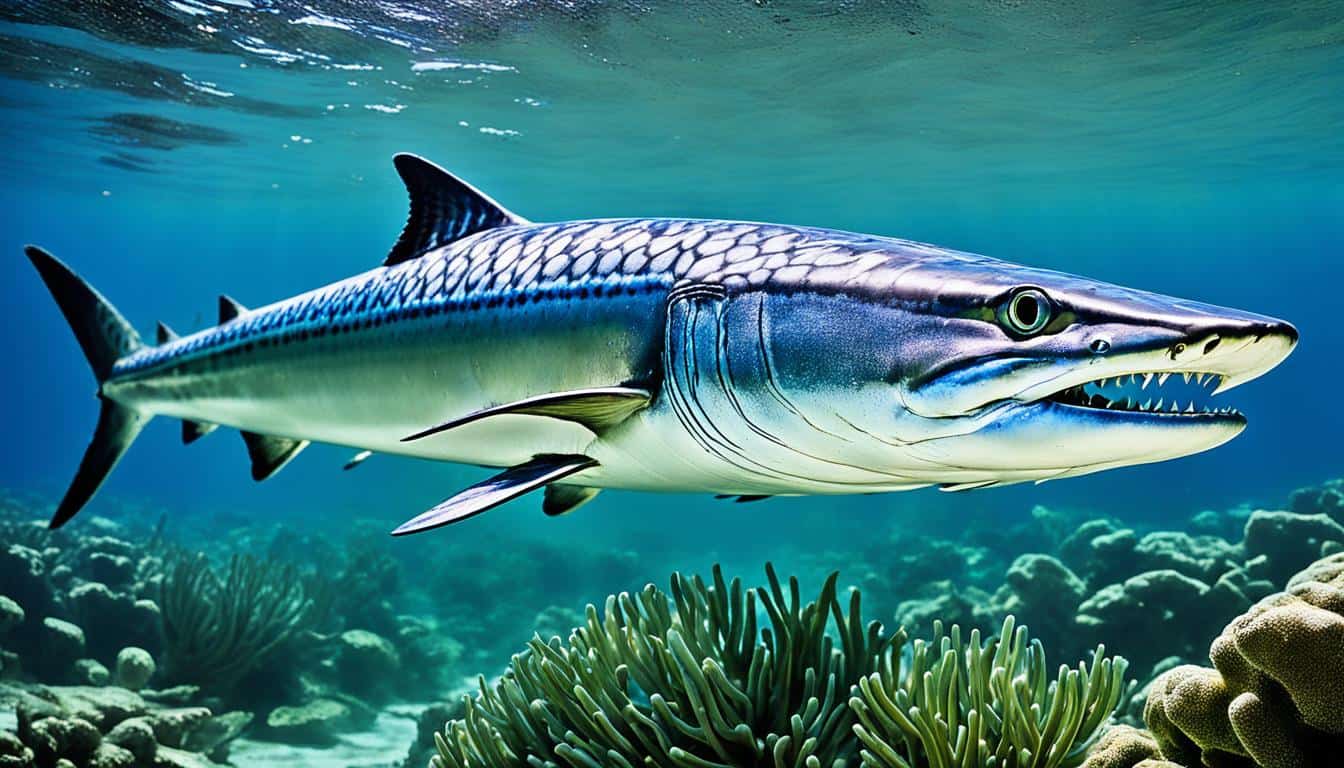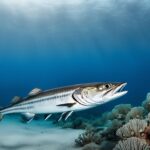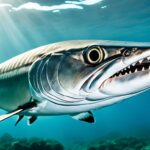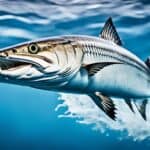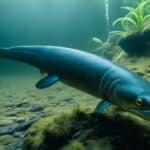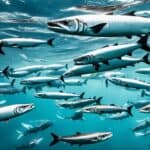Barracudas are fascinating fish that belong to the Sphyraenidae family. They have long bodies, sharp teeth, and are skilled hunters. The great barracuda is one of the most well-known species, reaching over 5 feet long and weighing up to 100 pounds.
These fish live in tropical and subtropical waters all over the world. They like to stay near coral reefs, seagrasses, and mangroves. Their unique look makes them stand out in the ocean.
Barracudas might look scary, but they usually don’t bother divers. They are often drawn to shiny things, thinking they are food. Learning about barracudas helps us understand their role in the ocean and the ecosystems they live in.
Understanding the Great Barracuda
The great barracuda is a fascinating fish found in the Caribbean and other warm waters. It is known for its barracuda characteristics and barracuda size. This fish is not just big but also a skilled hunter.
Description and Size
Some great barracudas can reach up to 10 feet long. Most are about 5-6 feet long. Their size helps them catch prey effectively. They have a blue-gray top and shiny silver and white bottom. Dark spots on their sides help identify them.
Physical Characteristics
The great barracuda has sharp teeth, perfect for catching slippery fish. Their bodies are built for speed, reaching up to 36 mph. They have special fins that help them move fast and catch prey.
Young barracudas have unique colors that help them blend in. This shows how adaptable and interesting this fish is.
| Feature | Details |
|---|---|
| Maximum Size | Up to 10 feet |
| Average Size | 5-6 feet |
| Coloration | Blue-gray to silver with dark spots |
| Teeth | Dagger-like, two rows |
| Speed | Up to 36 mph |
What are barracudas?
Barracudas are part of a unique fish family known for their long, thin bodies and sharp teeth. These fish live in warm waters and come in many barracuda species. Their looks and how they hunt make them interesting to those who love the sea.
One cool barracuda fact is how fast they can swim, helping them catch their food. As top predators, they keep the ocean’s balance. They mostly use their great eyesight to find food, showing they hunt by sight more than smell.
Meeting these fish can be exciting, but it’s important to know how they act. Barracudas can be aggressive, especially around shiny things. This can be risky for divers and snorkelers.
Barracuda Behavior
Barracudas show us how hunting and social life work together. They have special ways to survive and reproduce. These fish are very interesting to study.
Hunting Techniques
Great barracudas use speed and sneakiness to catch their food. They often go after fish like jacks and groupers. They hunt alone most of the time, but sometimes they hunt in pairs.
They have great eyesight, so they can see their prey from far away. Then, they dash in fast to catch their food. This skill helps them live in many different places and makes them top predators.
Social Structure
Even though barracudas are usually alone, they come together during breeding times. These groups are not strict like some animals. They form for hunting or to find a mate.
This way of living helps us understand how barracudas fit into their world. It shows how they work with each other in their own special way.
Barracuda Habitat
Barracudas live in warm, shallow waters in the western Atlantic and Indo-Pacific Oceans. They can be found in many places, from colorful coral reefs to rocky areas and seagrass beds. This lets different species fill various roles in marine ecosystems.
These fish stay in waters up to about 100 meters deep. Young barracudas hide in mangrove areas for safety. This helps them grow without being eaten by big predators.
When they get older, barracudas move to open waters but also like coastal areas. This shows how well they adapt to different environments. It also shows their important role in marine ecosystems.
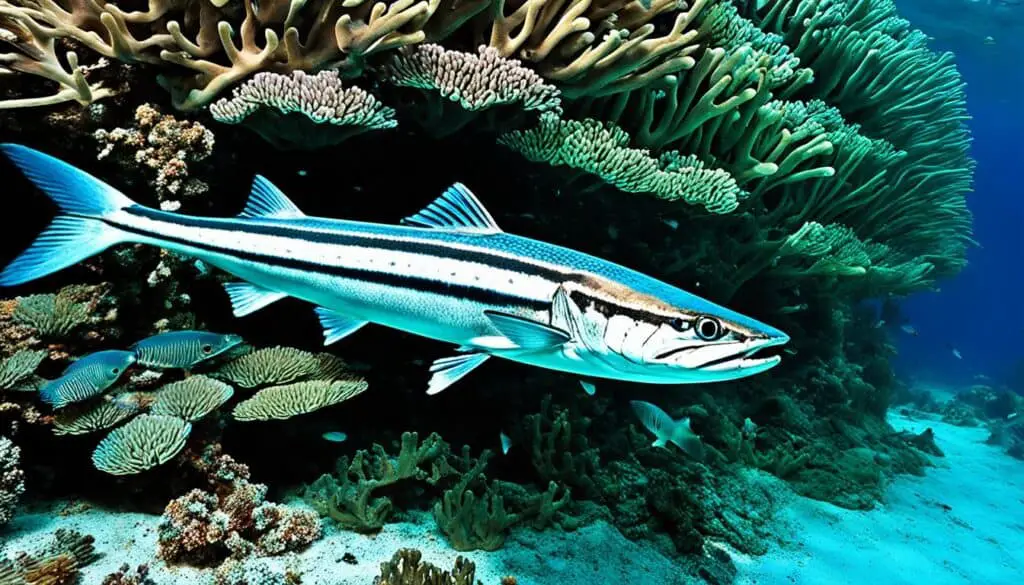
| Barracuda Species | Habitat Preferences | Depth Range |
|---|---|---|
| Great Barracuda | Coral reefs, open coastal waters | Surface to 100 meters |
| Needlefish Barracuda | Shallow, sandy areas | Surface to 50 meters |
| Blackfin Barracuda | Rocky substrates and reefs | Surface to 30 meters |
Barracuda Diet
The diet of a barracuda mainly includes different types of fish. Their eating habits show how they are skilled at finding food in the ocean. Barracudas hunt all day, using their speed and sharp teeth to catch their food.
Feeding Habits
Great barracudas are top predators in their homes. They eat fish like grunts, mullets, and smaller barracudas. They hunt during the day, using their speed to catch their prey. Here are some key facts about their eating habits:
- Active hunters that rely on speed
- Wide variety of fish species consumed
- Predatory strategies that include ambush and fast chases
Role in the Ecosystem
Barracudas play a big role in the ocean’s balance. As top predators, they keep the number of smaller fish in check. This helps keep their home healthy. Here are some important points about their role:
- Prevention of overpopulation in smaller fish species
- Promotion of species diversity
- Indicators of a healthy marine environment
Understanding the barracuda’s diet shows how important they are to the ocean. Their eating habits help keep the ocean’s balance. This balance is key to the health of marine life in many places.
Barracuda Conservation and Threats
Barracudas face many threats that affect their numbers and their homes in the ocean. They are not yet endangered, but they face big challenges like habitat loss, overfishing, and climate change. These issues harm their places to live, breed, and find food.
Overfishing is a big worry for barracuda conservation. Some fishing methods are not good for the ocean and hurt barracuda numbers. Barracudas are important because they keep the ocean’s balance. Without them, the ocean’s food chain could be upset.
We need to work on saving the barracudas. We can do this by fishing in a way that doesn’t harm the ocean and protecting their homes. It’s also important to teach people why barracudas matter. This way, we can keep the ocean healthy for them and for us.
FAQ
What are barracudas?
Barracudas are fish that belong to the Sphyraenidae family. They are known for their long bodies and sharp teeth. The great barracuda is the most well-known type.
What are some interesting barracuda facts?
Barracudas can grow up to 5 feet long and weigh as much as 100 pounds. They live in warm and tropical waters, often near coral reefs and mangroves. These fish are key predators in the ocean.
How large do barracudas typically grow?
Great barracudas can get up to 10 feet long. But, most are about 5-6 feet long.
What characteristics define the great barracuda?
The great barracuda has a sleek body and a sharp snout. It has a blue-gray color and sharp teeth. It can swim as fast as 36 mph, making it a great hunter.
What behaviors do barracudas exhibit while hunting?
Barracudas use speed and sneakiness to catch their prey, usually smaller fish. They hunt alone but sometimes work together when mating or hunting.
Do barracudas have a social structure?
Barracudas are usually alone but gather in small groups to spawn. They don’t have a strict social order.
What type of habitat do barracudas prefer?
Barracudas live in warm, shallow waters in the western Atlantic and Indo-Pacific. They like coral reefs, rocky places, and seagrasses, staying up to 100 meters deep.
What does a barracuda’s diet consist of?
Barracudas eat smaller fish like grunts and mullets. They hunt in all water layers, showing their hunting skills.
What role do barracudas play in their ecosystems?
As top predators, barracudas keep fish populations in check. They help maintain the balance in marine ecosystems, showing a healthy ocean.
What threats do barracudas face?
Barracudas are threatened by habitat loss, overfishing, and climate change. Conservation efforts aim at sustainable fishing and protecting their homes.
How do barracudas reproduce?
Barracudas spawn in shallow, warm waters, releasing eggs and sperm. The young grow in safe places like mangroves, away from big predators.

